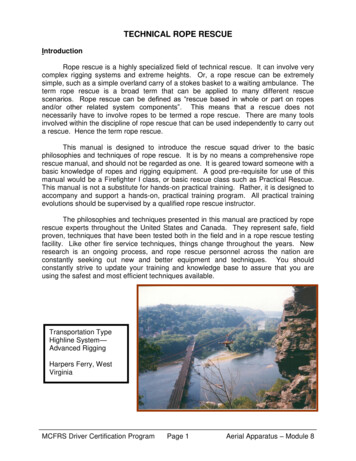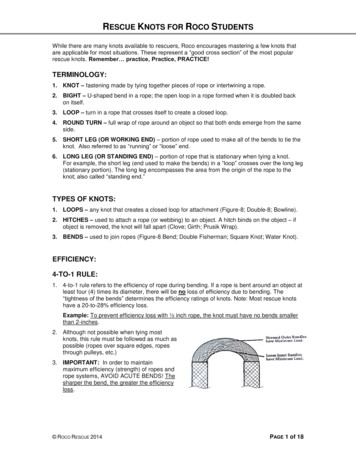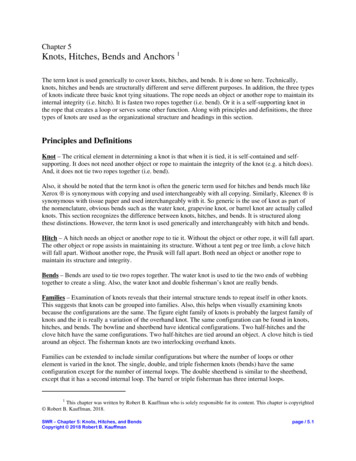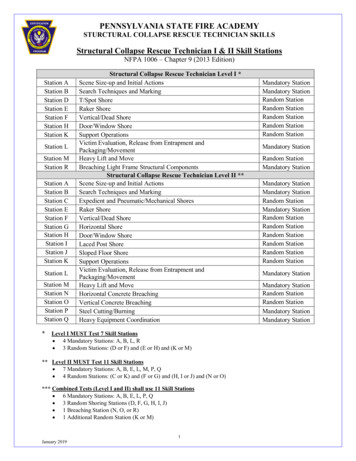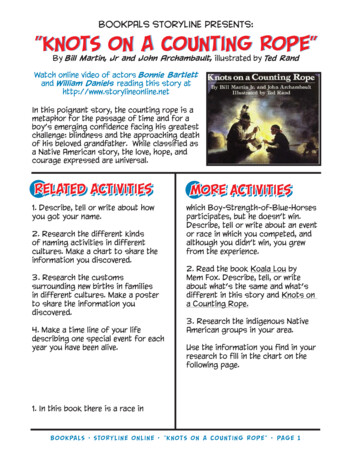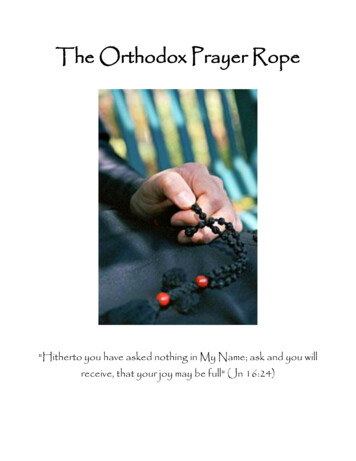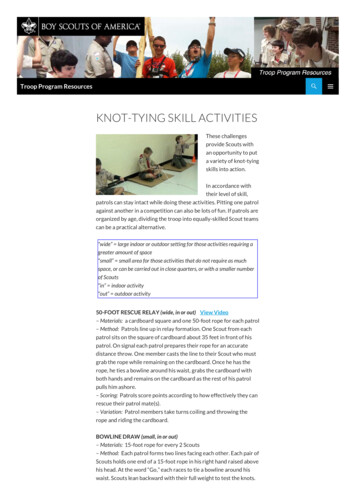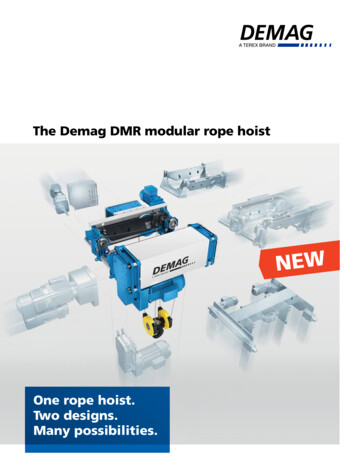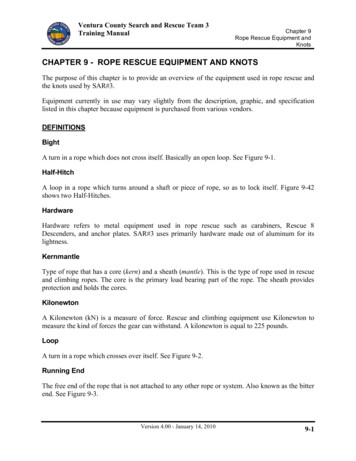
Transcription
Ventura County Search and Rescue Team 3Training ManualChapter 9Rope Rescue Equipment andKnotsCHAPTER 9 - ROPE RESCUE EQUIPMENT AND KNOTSThe purpose of this chapter is to provide an overview of the equipment used in rope rescue andthe knots used by SAR#3.Equipment currently in use may vary slightly from the description, graphic, and specificationlisted in this chapter because equipment is purchased from various vendors.DEFINITIONSBightA turn in a rope which does not cross itself. Basically an open loop. See Figure 9-1.Half-HitchA loop in a rope which turns around a shaft or piece of rope, so as to lock itself. Figure 9-42shows two Half-Hitches.HardwareHardware refers to metal equipment used in rope rescue such as carabiners, Rescue 8Descenders, and anchor plates. SAR#3 uses primarily hardware made out of aluminum for itslightness.KernmantleType of rope that has a core (kern) and a sheath (mantle). This is the type of rope used in rescueand climbing ropes. The core is the primary load bearing part of the rope. The sheath providesprotection and holds the cores.KilonewtonA Kilonewton (kN) is a measure of force. Rescue and climbing equipment use Kilonewton tomeasure the kind of forces the gear can withstand. A kilonewton is equal to 225 pounds.LoopA turn in a rope which crosses over itself. See Figure 9-2.Running EndThe free end of the rope that is not attached to any other rope or system. Also known as the bitterend. See Figure 9-3.Version 4.00 - January 14, 20109-1
Chapter 9Rope Rescue Equipment and KnotsVentura County Search and Rescue Team 3Training ManualSoftwareSoftware refers to the soft equipment used in rope rescue such as ropes, webbing, and Prusiks.Software is generally made out of nylon.Standing PartThe fastened part or the whole rope other than the running end. See Figure 9-3.Figure 9-1: BightFigure 9-2: LoopFigure 9-3: Rope PartsGENERAL RULES FOR GOVERNING ROPE WORKRope rescue equipment is used as a personal life support and for rescue operations. Although theequipment is sturdy and can handle the stresses of a rescue operation, care must be taken duringan operation and in storing the equipment.1. Never walk on a rope. Stepping on a rope is a cardinal sin, usually calling for prompt anduncouth comments. Stepping on a rope will needlessly cause small particles of dirt androck to be pushed into the rope fibers, causing internal wear that is extremely difficult todetect.2. Do not allow the rope to run over sharp or rough edges, especially if it is loaded.3. Never expose rope to any chemicals such as gasoline, thinners, oil, road flares, etc. Thisincludes storing ropes in automobile trunks with oily rags or where fumes mayaccumulate.4. Store rope in a clean, dry, cool area whenever possible, and never store rope wet. Storethe rope in a protective storage bag. This provides protection for the rope as well asassuring that the rope should not tangle when it is needed.5. Examine the rope periodically during use, and immediately after it has held a fall or beenhit by falling objects. Any suspect rope shall be noted and removed from active use untilit can be inspected by the team equipment officer. If a rope is at all suspect it should beretired. If puffs of inner fiber are visible along the rope, retire it immediately. During usea Butterfly Knot can be used to temporarily isolate a damaged rope section.6. Do not leave the rope stretched or under tension for extended lengths of time. Remove allknots before storing the rope.9-2Version 4.00 - January 14, 2010
Ventura County Search and Rescue Team 3Training ManualChapter 9Rope Rescue Equipment andKnots7. During an operation the rope will undoubtedly be dragged against rock faces, throughdirt, and over brush. Sharp edges could easily cut the best line if the conditions arecorrect and the rope is under tension. Whenever possible minimize the rope's exposure tosharp edges through the use of padding for static lines. Smooth surface protection or edgerollers should be utilized for moving lines of raising or lowering systems. Especially padthe area of the rope near the edge of a cliff when rappelling.8. After each use of a rope it should be logged in the team rope log in the rescue room.9. Do not drop hardware. Any hardware drop from a significant height onto a hard surfaceshould be removed from the system.10. If hardware is resting on a hard surface or may bounce on a hard surface during thenormal course of the operation, the area should be padded or the hardware moved.11. Keep hardware out of the dirt. If the hardware must be close to the dirt use a tarp or otherprotection to keep the hardware clean. Put hardware not in use either on one’s harness,clipped to the anchor, or in the equipment cache.Washing and Drying of RopesTeam ropes that have been used either for an operation or training should be cleaned uponreturning to Station 10. The rope should be cleaned using the rope washer. While feeding therope through the rope washer the rope should be inspected for any defects. The rope should becoiled and hung to dry completely in the rescue garage.Personal sections of 9 mm rope can be washed at home in an automatic washer. Larger sectionsof 11 mm or larger rope should be cleaned using a large commercial machine. Double-up andchain stitch the rope, and use a nylon safe detergent such as Woolite . Set the machine for"gentle action", warm wash and cool rinse. Rinse twice if any soap is left on the rope.The preferred method of drying is to hang the rope in a cool, shady place, however, it can beplaced in a dryer on the "cool" or "air dry" setting. Keeping a rope clean is vital for safety andmaximum rope life.Storage of Ropes and WebbingRescue ropes are stored in the truck in rope bags. The bag allow theropes to be carried into the field and deployed without kinks in the rope.Rope bags allow more control in dropping of the rope down a cliff toavoid hitting the victim. A rescuer may rappel with the rope bagattached to the harness to completely avoiding dropping the rope ontothe victim or if there is heavy brush that may snag the rope.Rope bags have a hole at the bottom of the bag. This is to prevent therope and bag separating when the rope is deployed. When putting arope into the bag a stopper knot is placed in the rope about four feet Figure 9-4: Stuffing aRopebefore the end of the rope. The rope is push through the hole from theVersion 4.00 - January 14, 20109-3
Ventura County Search and Rescue Team 3Training ManualChapter 9Rope Rescue Equipment and Knotsinside and another stopper knot is tied at the end of the rope on the outside. This way the ropewill stay with the bag and the rope will not be pulled out from bottom.When putting the rope into the bag, also known as stuffing, the rope is pushed into the bag inline. Do not grab a hand full of rope and shove it into bag. That may cause the rope to jam in thebag. Figure 9-4 shows a common way of feeding the rope through a carabiner attached to aharness to stuff a rope.An alterative way of storing and transporting is to chain it. This is generally done when a ropebag is unavailable. While sitting down on the ground with knees apart, wrap the rope around theknees about five turns. Then start chaining the rope around the turns until the end of the rope.See Figure 9-5.Figure 9-5: Chaining a RopeWebbing is chained. See Figure 9-6. The key tosuccessful chaining of webbing is that when thewebbing is unchained there are no knots at theend. For long longer lengths of webbing thewebbing can be folded into quarters to make thefinal chained webbing shorter.Figure 9-6: Chained WebbingClimbing rope kept in SAR#3 trucks are kept in rope bags. But generally climbing ropes arecoiled using traditional climbing techniques.Rope and Webbing IdentificationEach rope placed into service is identified at each end with a label. The label indicates the lengthof the rope, the year the rope was placed into service, and the rope sequence number.Webbing is identified on ends with the length of the piece and the month and year it was placedin service. Personal webbing should also be identified with the member’s name. Webbing shouldbe discarded after the current years of service limitation.ROPES AND WEBBINGRopes used in mountain rescue serve a three-fold purpose:1. As an aid in mountaineering9-4Version 4.00 - January 14, 2010
Ventura County Search and Rescue Team 3Training ManualChapter 9Rope Rescue Equipment andKnots2. As an aid in victim evacuation3. In a safety system.Static Rope SpecificationsStatic rope, also known as low-stretch rope, is the primary rope used for rope rescue. Static ropehas a maximum elongation less that 6% at a load at 10% of the rope’s minimum breakingstrength.SAR#3 uses static rope made by various manufactures. The information in Table 9-1 is for thecurrent New England Ropes in use. The specifications from other manufactures are similar. Thebreaking strength in Table 9-2 uses 3 sigma statistical method for reporting minimum breakingstrength that provides a 99.87% certainty of the result.The primary ropes used by SAR#3 are 200 feet in length, 1/2 inch in diameter, and kept in ropebags. Other ropes available are 7/16-inch, 200-foot, 300-foot, and 400-foot ropes. Currentpersonal rope issued is 3/8-inch, 100-foot ropes.Knots, bends, and other factors will reduce the strength of the rope.ModelConstructionFiberSheathTemperatureNew England KM III Static Kernmantle Rescue RopeBlock creel, static kernmantle constructionThe core is 100% nylon and the sheath is 100% polyesterBraided polyester jacket, 32 carrier, two over-two underconstruction with half of the strands having a Z-twist andhalf having a S-twistMelt point 480 F (248 C)Table 9-1: Static Rope SpecificationsDiameterin rengthlb (kN)5,000 (24)7,000 (31)9,900 (44)11,900 (53)Weightlb/100 ft4.75.47.010.2Table 9-2: Static Rope Breaking Strength and Weight by DiameterClimbing Rope SpecificationClimbing rope, also known as dynamic rope or high-stretch rope, is used in climbing situationswhere the rope would stretch and absorb the energy of a fall. SAR#3 uses 11 mm (7/16 in)climbing rope with a length of 50 m (165 ft). The breaking strength of the rope is 5,000 lb (22kN) with elongation at 176 lb of 6.7 %.Version 4.00 - January 14, 20109-5
Chapter 9Rope Rescue Equipment and KnotsVentura County Search and Rescue Team 3Training ManualClimbing rope is rated in dynamic falls. SAR#3 climbing ropes are rated at 9-11 falls.Webbing SpecificationWebbing can be used for anchors, tie-ins, and emergency harnesses. Webbing is flat or tubularand comes from 1/2 in up to 3 in. SAR#3 uses 1-inch tubular webbing with a breaking strengthof 4,000 lb (17 kN). The length of the webbing can vary depending on use. The length should bemarked on the end of the webbing. Fire departments use a standard color-coding (See Table 9-4)to indicate the length of the webbing used in rescue systems. Table 9-3 lists the color-coding forthe length of webbing used by SAR#3 though this is not a hard rule.System PackSystem PackSystem PackSystem PackPersonalGreenYellowBlueRedOrange5 ft12 ft15 ft20 ft20 ftTable 9-3: SAR#3 Webbing Color-CodingGreenYellowBlueOrange5 ft12 ft15 ft20 ftTable 9-4: Fire Department Webbing Color-CodingPrusik Cord and Utility Cord SpecificationPrusik cord is primary used for Prusik hitches and load release hitches. Utility cord is used for acordelette. Prusik cord uses kernmantle construction. Table 9-5 shows the use of Prusik cordcurrently in use by SAR#3 and its specifications. Colors may vary as new stock is obtained.UseTandem Prusik - shortTandem Prusik - longLoad Release HitchCordeletteTypicalColorYellow / BrownBlue / reakingStrengthlb (kN)2,875 (12)2,875 (12)2,875 (12)2,875 (12)Table 9-5: Prusik Cord Use and SpecificationsHARDWAREBecause SAR#3 is a wilderness SAR team and needs to carry its gear into the backcountry thehardware the team uses is primarily made out of aluminum alloy rather than heavier steel.9-6Version 4.00 - January 14, 2010
Ventura County Search and Rescue Team 3Training ManualChapter 9Rope Rescue Equipment andKnotsATC (a.k.a. Black Diamond Air Traffic Controller)The ATC is used as a personal belaying device. It can be used for rappelling oras a climbing belay device. The ATC should never be used in any rescuesystems. An ATC is shown in Figure 9-7.Carabiners (a.k.a. Biners)Carabiners are used as a link. There are three basic types of carabiners asshown in Figure 9-8.Locking CarabinerNon-Locking CarabinerFigure 9-7:ATCAuto-Locking CarabinerFigure 9-8: Types of Carabiners1. Locking carabiners uses a locking nut to lock the gate. They are generally “D” shaped.Rescues systems uses locking carabiners exclusively. Figure 9-9 shows the parts of alocking carabiner.2. Non-locking carabiners are used by climbers because they are very quick to connect anddisconnect from the rope. Non-locking carabiners come in the traditional oval shape orspecific shapes for specialized applications. Non-locking carabiners are used in pairs.Figure 9-10 shows the correct “opposite and opposed” use when used in pairs. There arevery few non-load bearing use of non-locking carabiners in rescue systems such in a“keeper” for a load releasing hitch.Figure 9-9: Parts of aCarabinerFigure 9-10: Non-locking Carabiner"Opposite and Opposed"Version 4.00 - January 14, 20109-7
Chapter 9Rope Rescue Equipment and KnotsVentura County Search and Rescue Team 3Training Manual3. Auto-locking carabiners have an automatic locking mechanism. These carabiners are forpersonal use where quick access and locking of a carabiner is necessary such asrappelling from a helicopter.The standard size carabiners that SAR#3 uses are classified to NFPA 1983-Light Use. Table 9-6shows the strength of carabiners.SizeStandardLargeBreakingStrengthlbs. (kN)6,069 (27)7,643 (34)Table 9-6: Locking Carabiner StrengthThe purpose of the locking nut is to prevent the gate from being open. The locking nut does notneed be tighten completely. During an operation a carabiner will flex as the load increases anddecreases. If the locking nut is too tight it is possible that the nut becomes impossible to loosenwhen the load is released.The load on a carabiner should always be down the spine and not across the carabiner which isknow as “cross loading”. Carabiners in use should be checked periodically to make sure that theyhave not shifted and become cross loaded. A carabiner should not be located at the edge where itwill be loaded on the edge. The carabiner should be relocated by adjusting the anchor.The best way to use a carabiner is the “bite down and twist” method as shown in Figure 9-11 thatallows easy access to the gate.Bite the opening of the gatedown on the anchor pointTwist carabiner so that gateopening is easily accessedFigure 9-11: Carabiner Bite Down and TwistRescue 8 Descender (a.k.a. Figure 8)The Rescue 8 descender is a friction device used for rappelling and lowering systems. The “ears”of the Rescue 8 Descender helps prevent the rope creating a girth hitch around the device andmake it easier to lock off. Figure 9-12 shows the correct threading of a rope through the Rescue 8Descender. The rope is fed through the bottom of the Rescue 8. A disadvantage of the Rescue 8Descender is that it will twist the rope as it goes though.9-8Version 4.00 - January 14, 2010
Ventura County Search and Rescue Team 3Training ManualChapter 9Rope Rescue Equipment andKnotsAdditional friction can be gained by adding an additional wrap on the Rescue 8 descender.Brake Bar Rack Descender (a.k.a. Rappel Rack)The Brake Bar Rack Descender is an alternative friction device for rappelling and lowering.Unlike the Rescue 8 Descender the Brake Bar Rack does not twist the rope. Figure 9-13 showsthe threading of the Brake Bar Rack. The amount of friction can be adjusted by adding orsubtracting the number of bars. The amount of friction can also be adjusted by adjusting thespacing between the bars. A major disadvantage of the Brake Bar Rack is that is can becompletely removed from the rope without unclipping the attaching carabiner.Figure 9-12: Rescue8 DescenderFigure 9-13:Brake Bar RackAnchor Plate (a.k.a. Brenner Plate, Rigging Plate, Paw Plate)Anchor plates helps organize the rigging of a system at the anchorcollection point. SAR#3 uses a standard four-hole aluminum plate asshown in Figure 9-14.The “Brenner Plate” is named after ex-SAR#3 team member DavidBrenner who designed the anchor plate.Figure 9-14:Anchor PlatePulleysPulleys are used to change the direction of moving ropes and to build mechanical advantagesystems. The bearing of pulleys are either sealed ball bearing or oilite bushing. SAR#3 uses fourtypes of pulleys as shown in Figure 9-15.Version 4.00 - January 14, 20109-9
Chapter 9Rope Rescue Equipment and KnotsStandard round-bottompulleys used forgeneral use.Ventura County Search and Rescue Team 3Training ManualDouble pulleys used formechanical advantagesystems.Prusik-minding pulleysused to help maintainPrusiks in systems.Knot passing pulleysallow knots to passthrough easily.Figure 9-15: Types of PulleysMechanical AscendersMechanical ascenders are used to ascend ropes. Mechanical ascenders may not be used in arescue system. The two makes used by SAR#3 are Gibbs and Petzl Rescucender. Handledascenders such as those made by Jumar or Petzl are used in climbing. See Figure 9-16.Gibbs AscenderPetzl RescucenderHandled AscenderFigure 9-16: Mechanical AscendersROPE PROTECTIONAll software including rope and webbing must be protected from sharp edges and abrasion thatmay damage or cut. There are many ways to provide this protection. Figure 9-17 shows three ofthe types of edge protection used by SAR#3. The protection must be secured so that it stays inthe needed location and does not fall.9-10Version 4.00 - January 14, 2010
Ventura County Search and Rescue Team 3Training ManualChapter 9Rope Rescue Equipment andKnotsSoft items such as packs and jackets can also be used for rope protection. These are best used innon-moving rope situations such as for sharp edges on an anchors. Care should be used whenusing these items on moving rope that there is no metal or plastic parts or connectors that willdamage the rope.Rope protection should also be used to prevent the rope from cutting into the dirt on a slope.Edge GuardUltra-ProEdge RollersFigure 9-17: Types of Edge ProtectionEdge Guards (a.k.a. Rope Condom)Edge Guards are either 18- or 24-inches in length, surrounds the rope or webbing and closes withhook-and-loop strip.Ultra-ProUltra-Pro is a flexible nylon pad with multiple grooves to guide multiple ropes.Edge RollersEdge rollers greatly reduces the friction of a moving rope over an edge protection. Disadvantageis they are heavy and bulky to carry into the field.KNOTSBasically, a knot is a configuration in one or more ropes, which is used:1. to create a stop,2. to tie the ends of two ropes together,3. to tie the end of a rope to an object or creating a loop,4. to tie the middle of a rope to an object, and5. create a friction knot.Version 4.00 - January 14, 20109-11
Chapter 9Rope Rescue Equipment and KnotsVentura County Search and Rescue Team 3Training ManualReliability, ease of tying, and experience are the criteria in selecting the few basic knotspresented herein. Although a great many more knots exist, many are unsuitable for rescue usage.Further study beyond the limited scope of this manual is recommended. Some knots are knownby different names. The knot’s alternative names are listed with the predominate SAR#3 name.The knots used must be learned well enough so that each knot can be tied correctly the first time,even under adverse conditions. Knots should be inspected frequently when subjected to long useand bad weather, especially since knots tied on nylon rope tend to slip due to the smoothness ofthe fibers. To counter this, all knots shall be tied off with an overhand knot unless otherwisenoted. Neatness counts in knot tying. The knot should be dressed eliminating any extra bends ortwists. This makes the knot stronger and easier to check.Remember, the success of every rescue operation can be dependent upon the reliability of eachknot.Note that for clarity the safety overhand knot may not be shown in the figures.Basic KnotsOverhand KnotThe Overhand Knot the simplest knot to tie. It's used as a temporary stopon an unlashed rope or to supply a better handhold for climbing a singleline. The Overhand Knot is also used as a safety knot to secure the freeends of the rope in most other knots. See Figure 9-18.Figure 9-18:Overhand KnotFigure of Eight (a.k.a. Stopper Knot, Simple Figure Eight)The Figure of Eight is used on the ends of ropes to prevent them fromslipping through a pulley, descending device, or rope bag. It is bulkierthan the Overhand Knot, but forms more gentle turns in the rope. SeeFigure 9-19Figure 9-19: Figureof EightMule Knot (a.k.a. Munter Mule, Releasable Knot)The Mule Knot is used to lock-off a Munter Hitch, Brake Bar Rack, or an ATC. Figure 9-20shows locking off a Munter Hitch.9-12Version 4.00 - January 14, 2010
Ventura County Search and Rescue Team 3Training ManualChapter 9Rope Rescue Equipment andKnotsHold the load on the Munter Hitch tightlyduring entire process and do not let goof the breaking hand, even for aninstant.Make a loop of rope exactly as shown.Pass a bight of rope through this loop asshown, creating an overhand slip knot.While ensuring that the load will notsuddenly drop, tighten the overhand slipknot that was just made.With the bight of rope exiting the slip knotabove, tie an overhand knot around theloaded line.Clip a carabiner through the overhandknot back to the carabiner or to theloaded line.Figure 9-20: Mule KnotKnots for Connecting Two Ropes TogetherSquare Knot (a.k.a. Reefer Knot)The Square Knot is used to tie the ends of equal diameter rope together. It should not be used forlife support applications where tension varies considerably. This is typically used for utilityconnections or for securing bandages for splints etc. See Figure 9-21.Figure 9-21: Square KnotVersion 4.00 - January 14, 20109-13
Chapter 9Rope Rescue Equipment and KnotsVentura County Search and Rescue Team 3Training ManualWater Knot (a.k.a. Overhand Follow Through, Ring Bend)The Water Knot is used for tying the ends of flat or tubular webbing together. It is feasible to usethis knot to join rope together, however, since a Figure Eight Bend is superior, it will be used forjoining rope. Safety knots are not required to finish off the knot but it is imperative that the tailsare at least 3 inches long. See Figure 9-22.Figure 9-22: Water KnotFigure Eight Bend (a.k.a. Flemish Bend)Figure Eight Bend is the primary knot used to tie ropes of equal diameter together. See Figure9-23.Step 1Step 2Step 3Step 4Figure 9-23: Figure Eight BendDouble Fisherman (a.k.a. Grapevine Knot, Double Overhand Bend, Tape Knot)The Double Fisherman is used to tie together two ropes of either equal or unequal diameter, or tomake a Prusik loop. Once loaded, it's difficult to untie which makes this an inferior knot withrespect to the Figure Eight Bend for joining ropes for systems operations. Safety knots are notrequired to finish off the knot. However there should be at least one inch of tail on both sides ofthe knot. See Figure 9-24.9-14Version 4.00 - January 14, 2010
Ventura County Search and Rescue Team 3Training ManualUsing one end of rope, tie adouble Overhand Knot aroundthe other end of ropeNow flip the rope over and onceagain tie a double Overhand Knotaround the other end of ropeNotice in step 1 that the end of ropewith a blue circle on it is on theright side, and when the rope isflipped over then the end of ropewith a blue circle is now on the leftside. It works best if the knot instep 1 is tighten before flipping therope over to tie the second knot,but the first knot was left un tightened in step 2 just for thesake of clarity.Chapter 9Rope Rescue Equipment andKnotsAfter tightening the two knots,pull them together and theyshould stack nicely next toeach otherFigure 9-24: Double FishermanKnots Used to Create a LoopFigure of Eight on a Bight (a.k.a. Figure Eight Loop, Flemish Loop)The Figure of Eight on a Bight is used to make a loop at the end or in the middle of a rope. It'seasier to tie than a Butterfly Knot and is stronger than a bowline. It can be used as an anchor knotor in any system used by this team. Both ends of the rope leaving the knot should be in the samedirection when the knot is loaded. Make sure to dress the knot properly so that all of the strandsof rope are parallel to each other and do not cross over each other. See Figure 9-25.Note that it is possible to tie this knot incorrectly, thus reducing its strength by 8 - 10 percent.Version 4.00 - January 14, 20109-15
Chapter 9Rope Rescue Equipment and KnotsVentura County Search and Rescue Team 3Training ManualFigure 9-25: Figure of Eight on a BightFigure of Eight Follow Through (a.k.a. Rethreaded Figure-Eight Loop)The Figure of Eight Follow Through is used to where a Figure Eight on a Bight cannot be usedsuch as a around a tree. It's also used to tie the end of a climbing rope in a sit harness. To use thisknot to secure a sit harness into a climbing line, first tie the Figure of Eight, pass the running endthrough the harness attachment, then complete the Figure of Eight Follow Through. Thisprovides the most secure harness tie in for climbing applications. See Figure 9-26.Figure 9-26: Figure 8 Follow ThroughInline Figure Eight (a.k.a. Directional Figure-Eight Knot)The Inline Figure Eight is used when the knot and the end of the rope will be loaded at the sametime such as a collection point. The Inline Figure Eight should not be used as a middleman knot.A safety knot is not required to finish off the knot. See Figure 9-27.9-16Version 4.00 - January 14, 2010
Ventura County Search and Rescue Team 3Training ManualChapter 9Rope Rescue Equipment andKnotsFigure 9-27: Inline Figure EightBowlineThe Bowline can be used to secure an end man on a belay, or used as an anchor knot. It's easy totie, but must be tied off to insure it won't loosen when the rope is slack. When looping a ropearound a boulder or a tree to create an anchor, the Bowline knot should be utilized. Note that it ispossible to tie this knot incorrectly by having the running on the outside of the loop, thusreducing its strength by one-half. See Figure 9-28.Figure 9-28: BowlineBowline on a Bight (a.k.a. Double Loop Bowline)The Bowline on a Bight is a very useful anchor knot. It can be used with offset sized loops toform a self-equalizing anchor. This may also be used to secure the middle of the rope when bothends of the rope are required for the system being used. Be careful when tying this knot as it caneasily be tied into a slip knot. See Figure 9-29.Version 4.00 - January 14, 20109-17
Chapter 9Rope Rescue Equipment and KnotsVentura County Search and Rescue Team 3Training ManualFigure 9-29: Bowline on a BightBowline on a CoilThe Bowline on a Coil is used to secure a climber into a climbing line when the climber is notwearing a climbing harness. This technique has the advantage that there is nothing to failbetween the climbing rope and the climber as is the case when tying into a climbing harness.Falling on this knot is more irritating than falling in a sit harness. The knot should be tied snuglyaround the smallest section of the abdomen. This knot should be used to attach a belay whenrappelling or ascending. See Figure 9-30.Starting position. Thecoil that makes up themajor loops would bearound your waist.Before settingFigure 9-30: Bowline on a CoilSet and secured. Notethat the backup knotgoes around all of theloops.Middleman KnotsThere are two middleman knots authorized for use by SAR#3. The knots are interchangeable butthe rescuer should be familiar with both knots so they can identify both as safe and acceptedknots. This is used to tie a loop in the middle of a rope or to isolate a damaged section. Whenloaded the two ends of the rope leaving the knot are to be in opposite directions. The loop of theknot may be loaded in any direction including 90 degrees with respect to the rope.9-18Version 4.00 - January 14, 2010
Ventura County Search and Rescue Team 3Training ManualChapter 9Rope Rescue Equipment andKnotsA safety knot is not required to finish off middleman knots.Butterfly Knot (a.k.a. Alpine Butterfly Knot)The Butterfly Knot is the primary middleman knot used by SAR#3. Figure 9-31 show thetraditional SAR#3 technique. Figure 9-32 shows an alternative technique to tie the ButterflyKnot.Figure 9-31: Butterfly KnotGrab the main lineand turn once toform a loop(shown). Turnagain to form asecond loop.Fold the secondloop over thefirst.Pass the secondloop around themain line andthrough the firstloop.The completedalpine butterflybefore setting.Figure 9-32: Alternative Butterfly Knot TieBallatine Bowline (a.k.a. Wireman’s Knot)The Ballatine Bowline is an authorized middleman knot used by SAR#3 and used by senior teammembers. The Butterfly Knot is the preferred as it is the middleman’s knot used most in SARand mountaineering applications. See Figure 9-33.Version 4.00 - January 14, 20109-19
Chapter 9Rope Rescue Equipment and KnotsVentura County Search and Rescue Team 3Training ManualFigure 9-33: Ballatine BowlineHitchesPrusik Hitch (a.k.a. incorrectly Prussik Hitch)The Prusik Hitch is a friction brake knot used as a safety device in tandem Prusik belay,rappelling, litter evacuation, or ascending a rope. It grips the climbing line securely when undertension, but slips when pressure is released. The Prusik is considered a "soft" ascender since therope being ascended is not being impinged by a "hard" metallic device. Prusiks need to be atleast 2 - 3 mm less in diameter than the rope being wrapped to provide a good grip. Smallerwraps grip
knots before storing the rope. 9-2 . Version 4.00 - January 14, 2010 . Ventura County Search and Rescue Team 3 Training Manual . Chapter 9 . Rope Rescue Equipment and Knots . 7. During an operation the rope will undoubtedly be dragged against rock faces, through dirt, and over brush. Sharp edges could easily cut the best line if the conditions are
